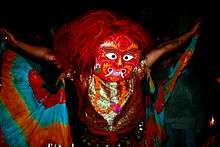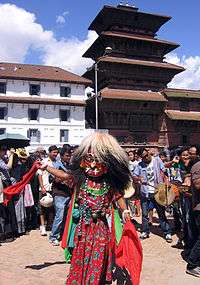Lakhey



Lākhey (Nepal Bhasa: लाखे, lā-khé) (alternative spellings Lākhe, Lākhay, लाखय्) is a demon in Nepalese folklore. He is depicted with a ferocious face, protruding fangs and mane of red or black hair. Lakhes figure prominently in traditional Newar culture of Nepal Mandala. The Lakhe tradition is found in the Kathmandu Valley and other Newar settlements throughout Nepal.[1]
Lakhes are said to be demons who used to live in the forests and later became protectors to the townspeople.[2] A female Lakhe is known as Lasin (लसिं).
The other common legendary being in Nepalese folklore is the Khyāh, who is depicted as a fat, hairy ape-like creature.
Dancing Lakhes
Lakhey Dance is one of the most popular dances of Nepal. Performers wearing a Lakhe costume and mask perform dances on the streets and city squares during festivals. The mask is made of papier-mâché and yak tails are used for the hair. The Lakhe dance is characterised by wild movements and thumping music.[3]
The most famous Lakhe is Majipa Lakhey of Kathmandu who appears during the Yenya (Indra Jatra) festival in September.[4][5] He is worshipped as a deity. City dwellers offer food and ritual items to him as he moves through the city accompanied by his musical band giving dance performances.
The Lakhe stops at major crossroads and market squares to give a performance. During the dance, a small boy known as Jhyalincha (झ्यालिंचा) taunts the Lakhe making him chase him in anger. Jhyalincha always manages to slip into the crowd and escape.[6]
Gunla Lakhe comes out during Gunla, the 10th month in the Nepal Sambat calendar which corresponds to August.
Other Lakhes
There are other Lakhes with particular characteristics. These mythical beings are said to reside in various parts of the city.
- Michyāh Lākhe (मिच्या: लाखे) (meaning "fire burning demon" in Nepal Bhasa) is a spirit who is said to cause fire by spontaneous combustion wherever it resides. People possessed by Michyāh Lakhe are also believed to cause fire.
- Minpu Lākhe (मिंपू लाखे) also causes fire.
References
- ↑ Gurung, Anuj (Spring 2009). "A Demon Among Deities". Cultural Survival. Retrieved 23 July 2012.
- ↑ Trussler, Simon and Barker, Clive (1 September 2003). New Theatre Quarterly 74, Volume 19. Cambridge University Press. ISBN 0521535891, 9780521535892. Page 127.
- ↑ "Lakhey Mask Dance". Cultural Affairs and Heritage Department, Government of Sikkim. Retrieved 24 July 2012.
- ↑ Toffin, Gérard (January 1992). "The Indra Jātrā of Kathmandu as a Royal Festival Past and Present". Contributions to Nepalese Studies. Center for Nepal and Asian Studies, Tribbuvan University. Retrieved 24 July 2012. Page 73.
- ↑ Koizumi, Fumio (1983). Dance and music in South Asian drama: Chhau, Mahākālī pyākhan and Yakshagāna. Academia Music. Page 5.
- ↑ Bajracharya, Chunda (2006). "Majipa Lakhe". In Prajapati, Subash Ram. The Masked Dances of Nepal Mandal. Thimi: Madhyapur Art Council. ISBN 99946-707-0-0. Page 19.